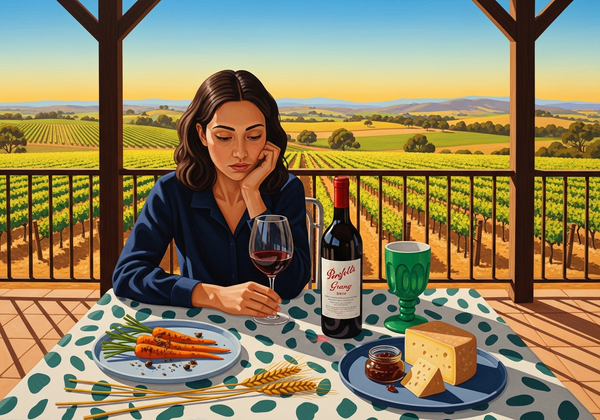Sarmiento Smoke & Cedar Memory: López de Heredia Viña Tondonia Gran Reserva 2001
Elder spice, Rioja soul: López de Heredia Viña Tondonia Gran Reserva 2001 loves cordero al chilindrón, marmitako, wood pigeon, cardoons, and piquillos; decant kindly.

I pour as evening gathers, and the glass shimmers like garnet laid over river stones—brick at the rim, ember at the core. The first curl of scent is cedar shavings and dried cherry, then sun-warmed orange peel, tea leaves, and a whisper of tobacco pouch. I give it a gentle splash-decant—age asks for kindness, not agitation—then return it to a tulip-bowled Bordeaux stem at 16–18 °C. The tannin, that soft drying weave, feels like brushed suede; the acidity is a taut wire under velvet. Give it thirty minutes and the graphite unknots into spice, like smoke trailing from vine canes after pruning.
From Spain’s Rioja DOCa, on the broad bend of the Ebro, this bottle is the work of R. López de Heredia, guardians of the Viña Tondonia terraces. Tempranillo leads with Garnacha, Graciano, and Mazuelo in support, rooted in limestone-clay flecked with gravel and river cobble. Traditional farming, long horizons, Atlantic drafts cooling warm, continental days—this is a place where stones lend backbone and the river teaches patience.
Time held in cedar and orange oil
Tondonia Gran Reserva is not a proclamation; it is a chronicle. The 2001 season gave Rioja balance and calm ripening, the kind of fruit that welcomes a long, careful élevage. The color is mature but alive. Aromas layer from redcurrant to saffron and sandalwood; old American oak offers spice more than sweetness—clove, coconut husk, a trace of dill—tucked beneath leather and tea. On the palate, medium in body yet deep in resonance, acidity glides, tannins are fine-grained, and fruit rests in the realm of compote and peel. The finish runs long with cedar, balsamic lift, and iron-spring freshness. I am Gesh, the vine’s archivist; each vintage I descend into the cellars like winter into soil, and return with the first swallows when the casks exhale stories.
Char, bone, and Rioja’s red heartbeat
Classic comforts deserve specificity. Cordero al chilindrón—lamb stewed with piquillo peppers and tomato—lets fat and gelatin soften the remaining grip while sweet red pepper threads into the wine’s dried-cherry core. The gentle paprika warmth echoes the oak’s spice without pushing bitterness. Or set cabrito asado on the table: wood-roasted kid, crackling at the edges, thyme stitched into the juices. The char folds neatly into cedar and tea, and the clean, delicate meat keeps the wine’s acidity bright rather than burdened. In both, protein invites tannin to relax; herb oils speak the vineyard’s language.
Adventures at the fire’s edge
Marmitako, the Basque sailor’s stew of albacore, potatoes, and peppers, is an unexpected ally. The bonito’s plushness softens the wine’s suede grip, while tomato-sweet stock and pepper savoriness keep the fruit lifted; that little seaside whisper dovetails with Tondonia’s balsamic freshness. For a land-born twin, try oak-grilled wood pigeon brushed with thyme and a lick of blood-orange glaze. The bird’s iron-rich flesh mirrors the wine’s mineral line; citrus picks up orange-peel aromas; grill smoke speaks directly to old oak and autumn leaves. I have tasted by torchlight in cavernous caves—there balance reveals itself most plainly, where flame meets bone and salt.
Forest-luxe for the vine’s scholar
Vegetarian luxuries feel native to this vintage’s autumnal register. Braised cardoons with almond and saffron deliver silk-on-silk texture; almond fat wraps tannin while saffron and cardoon bitterness tune the wine’s cedar and tea. Or serve wood-roasted celeriac lacquered with a brown-butter and oloroso reduction. The nutty sweetness draws out Tempranillo’s warmth; the sherry’s savory depth harmonizes with leather and balsamic notes. Texture is the covenant here: gloss meeting suede, root-sweetness balancing the wine’s cool, bright line.
Small indulgences, long echoes
Set a shallow dish of piquillo peppers stuffed with brandade under the broiler until edges blister. Salt cod and olive oil supply the cushion; pepper fruit hums with the wine’s dried strawberry and orange. Alongside, a clay pot of Tolosa beans with onion confit—no chorizo needed—lets creamy starch meet acidity, and the wine’s cedar line cut through with grace. When plates clear, I rarely chase sugar; I call for cheese. Aged Manchego or smoky Idiazabal is a soft landing, quince paste only as a brushstroke. A dry wine keeps its dignity when the last bite is savory.
I am the sister who keeps the harvest ledgers, who dreams with the sleeping vines and wakes before the first pruning cut. Honor this bottle with patience: a gentle splash-decant, good stems, a steady 16–18 °C, and watch how an hour transforms cedar into spice, spice into rose, rose into river stone. Drink now for tenderness, or follow its thread through 2032–2042 as leather and tea grow more complex and fruit turns to ambered peel. The sarmiento—the vine shoot—burns quick and bright; the vine endures. So does Tondonia 2001, carrying memory without weight, ready to sit with lamb or cardoon, pigeon or beans, and tell you what the river told the stones.
Elder spice, Rioja soul: López de Heredia Viña Tondonia Gran Reserva 2001 loves cordero al chilindrón, marmitako, wood pigeon, cardoons, and piquillos; decant kindly.





